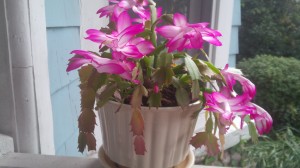 A generation or more ago, fall was a time when you would clean up the garden, put out a few mums, and plant the spring flowering bulbs. In the midst of all that, there was ample time to lose yourself watching the little wrens flitting through the aster stalks in search of delectable seeds. The wrens still flit, but now, the horticultural industry has made fall into a second spring. Mail order vendors ship perennials through the first weeks of October. Nurseries stock pansies, violas and a selection of perennials alongside the pumpkins, mums and gourds.
A generation or more ago, fall was a time when you would clean up the garden, put out a few mums, and plant the spring flowering bulbs. In the midst of all that, there was ample time to lose yourself watching the little wrens flitting through the aster stalks in search of delectable seeds. The wrens still flit, but now, the horticultural industry has made fall into a second spring. Mail order vendors ship perennials through the first weeks of October. Nurseries stock pansies, violas and a selection of perennials alongside the pumpkins, mums and gourds.
There is just so much to do.
All of this “second season” garden activity keeps you in constant motion, getting those last few perennials in the ground and plugging pansies into the bare spots. If you finish that before the weather gets nasty, you can still look forward to leaf removal, bulb planting, pruning and retrieving the houseplants from their warm weather vacation spots. In my garden, I must also stow the large rose pots in the garage and lift the dahlias if time permits.
All of that comes at a time when you are likely to be just a little tired of the garden and completely occupied with all the other business of life. The hours of precious daylight are waning, so little can be done in the evening after the workday is over. The challenge is to get the garden chores taken care of in a way that doesn’t make you feel like a lab rat stuck in a maze or a high school student confronting a timed test.
The only answer to this dilemma is multi-tasking, but it has to be done intelligently to work. Every action you take should serve more than one purpose and it helps to think in advance—if only a few minutes in advance. For example, you go out of the house to retrieve a houseplant that has summered in the front yard. Before you go, fill the watering can and take it with you. Water anything outside that needs moisture, then grab the rake or leaf blower and round up leaves for ten minutes. When you are finished, scoop up the houseplant and bring it inside. In the space of about fifteen to twenty minutes you have made a difference in the garden.
Make the most of small bits of time and large number of bulbs by making lasagna. In this case the “lasagna” is not a delectable pasta dish, but a time-honored method of planting lots of bulbs with minimal work. Do this by locating a place in your garden that needs spring color. Grab your spade, and bags of crocus, daffodils and tulips. Dig a hole that is about eight inches deep and twelve inches wide. At the bottom of the hole, deposit an odd number of daffodil bulbs—most likely five or seven will fit. Cover them with a thin layer of soil. Position the tulip bulbs atop that soil layer and cover with another thin soil layer. Finally, scatter crocus bulbs—probably seven or nine—atop the soil. Cover the crocus layer with several inches of soil. Don’t worry about possible collisions among the bulbs’ sprouts next spring. They always find their way and you will have a nice succession of blooms.
The lasagna method works for container gardens too. Just make sure that your container is deep enough to give all the bulbs enough room. If you don’t like daffodils, substitute hyacinths. Any little bulbs, like grape hyacinth or chionodoxa, can be substituted for the crocuses. The best rule of thumb is to plant the biggest bulbs the farthest down.
Another quick way to multi-task while getting the bulbs in is to pick an area of the garden that needs an amount of clean-up that can be done in about fifteen minutes. Clear away the dead annuals, cut back the desiccated perennial stalks and pull the weeds. Now that you have a bald spot. Dig a large hole and plant an odd number of bulbs in that hole. Cover and tamp down. If you use the lasagna method in the newly cleared space, you can make it a horticultural triple play.
Even if you don’t make lasagna, never plant a single bulb when you can plant a handful. If you are digging holes, the time saving rule is “go big or go home.” After all, who wants rows of tulips or daffodils that stand single file like wooden soldiers? I prefer naturalistic clumps, and planting multiple bulbs in a single large hole gives you clumps.
As for those late season perennials, you can also do double duty by cleaning up the area where you want the perennial, digging the planting hole in the newly cleared area and installing the bargain plant. Don’t forget to water if it hasn’t rained in a few days.
If all of the preceding sounds just a little frantic, it isn’t, at least not to me. At the end of a fifteen minute multi-tasking adventure, I feel purposeful and smart. The jobs get done before snow flies—usually.
